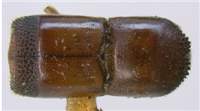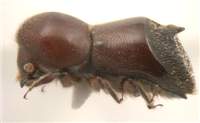Diagnosis
Large, stout species. Declivity obliquely truncated with large projections or with rugged, dense tubercles. Scutellum reduced or missing, elytral bases costate, curved, with conspicuous tufts of setae. Antennal club type 4, pubescent. Protibiae sickle-like, inflated and granulate posteriad.
Distribution
Palaeotropical.
Biology
Specialized to Dipterocapraceae. Larvae assist in creating a large communal chamber at the end of an entrance tunnel.
Taxonomy
Recently reviewed by Bright (1980).
Detailed description
Eyes deeply emarginate, sometimes almost disjunct, upper portion as large as lower part. Antennal club approximately circular, club type four (segment 1 small, second and third prominent on both sides). Segment 1 minor, its margin convex or bisinuate, segment 2 chitinous, glabrous, prominent, third segment clearly visible on both sides of club. Segment 1 of antennal funicle shorter than pedicel, funicle 4-segmented, scapus regularly thick. Frons above epistoma rugged, coarsely punctate. Submentum deeply impressed, shaped as a distinct large triangle. Anterior margin of pronotum straight or concave, densely asperate, its margin with distinct row of serrations, posterior edge (base) of pronotum broadly concave-emarginate, posterior shoulders angulately produced. Pronotum from lateral view inflated anteriad (type 4). From dorsal view it is subquadrate (type 3), or quadrate, robust (type 4). Pronotal disc with asperities resembling those on frontal slope. Lateral edge of pronotum obliquely costate, with produced costate shoulder. Procoxae contiguous, prosternal posterocoxal process short and conical, or flat and inconspicuous. Tuft on pronotal basis associated with mesonotal mycangium absent, but setae on elytral bases associated with elytral mycangium abundant. Scutellum not visible. Elytral bases broadly sinuate to accommodate openings of elytral mycangia. Elytral disc longer than declivity, flat, punctures on elytral disc irregular. Declivity markedly separated from disc. Lateral profile of elytral declivity obliquely truncated and steep, especially towards apex, dorsal profile of elytra obliquely truncated with rounded apical margin. Elytral declivity with few setae or scales, not conspicuously pubescent, or covered with dense setae. Posterolateral declivital costa absent or indefinable. Declivity coarsely granulated, or with long teeth and projections. Protibiae with evenly rounded edge, posterior side of protibia appears inflated and densely granulated. Protibial denticles small and numerous, bases of denticles not enlarged. Metatibiae of normal size. Large species, robust, 3.4-5.2 mm. Light or dark brown. Length: 3.4-4.8 mm.


